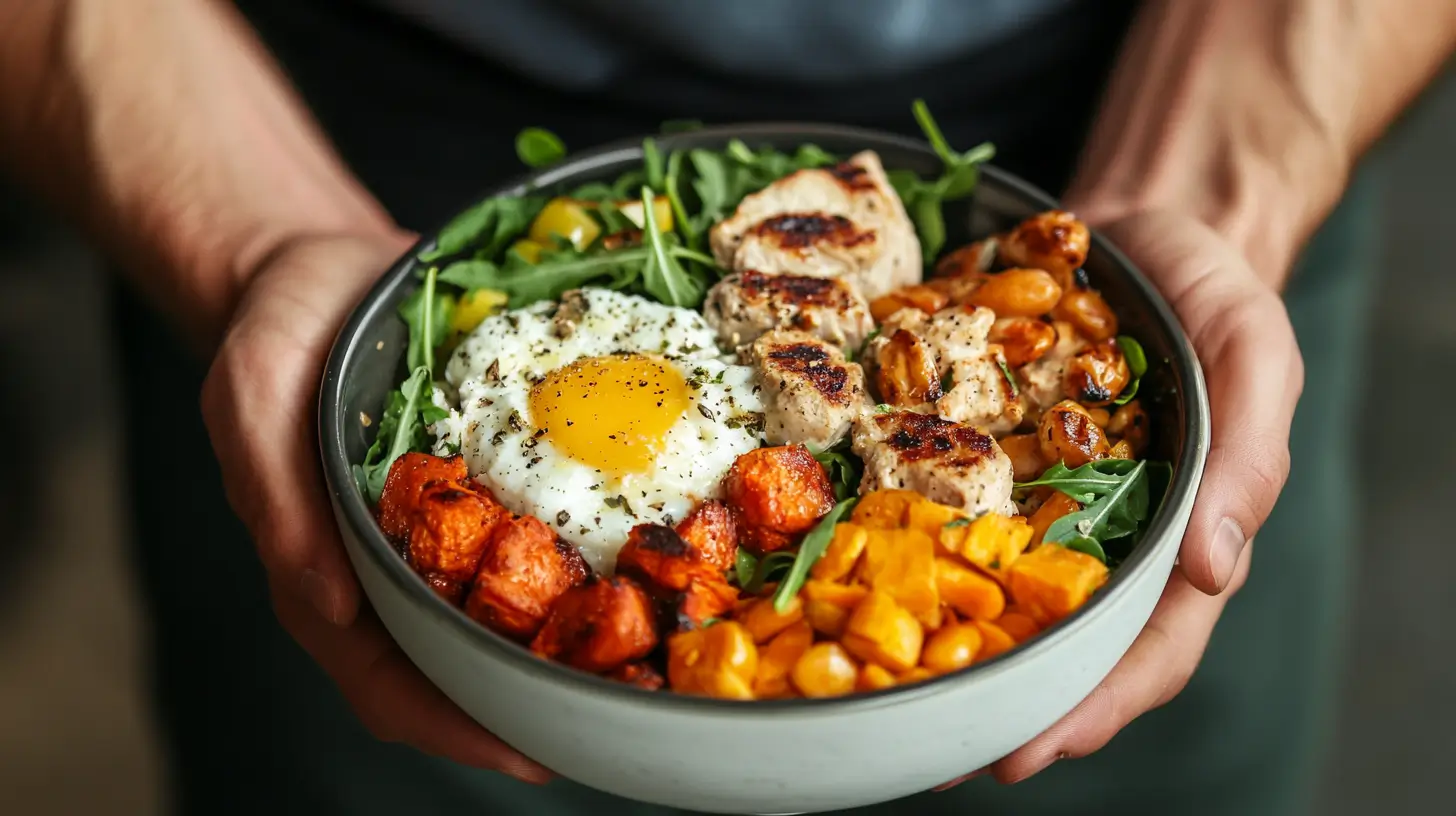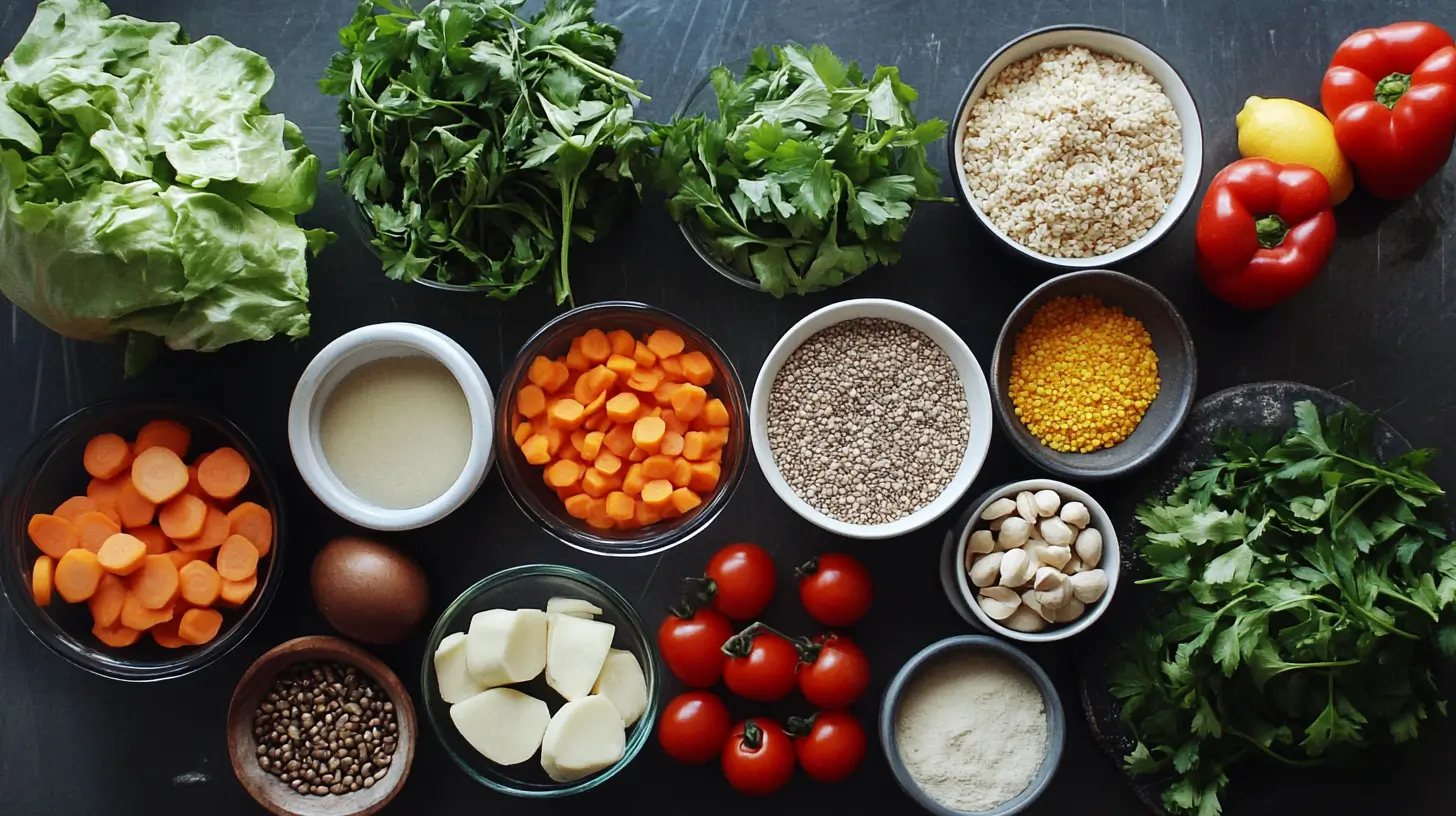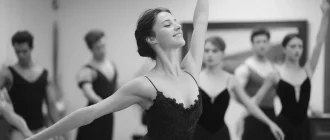The ballerina diet focuses on maintaining a lean physique and fueling intense training. This guide reveals the eating habits and nutrition strategies of ballet dancers to achieve peak performance and maintain a lean physique.
Graceful Insights
- The Ballerina Diet focuses on balanced nutrition, combining proteins, healthy fats, and complex carbohydrates to fuel rigorous training and support recovery.
- Mindful eating and regular meals and snacks throughout the day help ballet dancers maintain their energy levels, avoid fatigue, and develop a healthier relationship with food.
- Hydration is key. Dancers must drink plenty of water and electrolyte-rich beverages to stay hydrated and avoid consuming empty calories, which can optimize their performance.
Ballerina Diet Podcast
| Eating Habit | Description | Benefits | Example Foods |
|---|---|---|---|
| Start the Day with a Balanced Breakfast | In the morning, consume proteins, complex carbs, and healthy fats. | Kickstart metabolism; provides sustained energy. | Oatmeal with berries and nuts; Greek yogurt with granola; Whole-grain toast with avocado and egg. |
| Frequent Small Meals | Eat 5–6 small meals throughout the day. | Maintains energy levels; prevents overeating. | Snacks like nuts, fruits, and veggies; small meals with lean protein and whole grains. |
| Hydrate Adequately | Drink water consistently; include hydrating foods. | Supports muscle function and aids digestion. | Water, herbal teas, coconut water, cucumbers, and watermelon. |
| Prioritize Lean Proteins | Include sources of lean protein in meals and snacks. | Aids muscle repair and growth; increases satiety. | Chicken breast, turkey, fish, tofu, legumes. |
| Includes complex Carbohydrates | Choose whole grains and fiber-rich carbs. | Provides sustained energy; supports digestive health. | Brown rice, quinoa, whole-wheat pasta, sweet potatoes. |
| Consume Healthy Fats | Incorporate unsaturated fats into your diet. | Supports joint health and aids nutrient absorption. | Avocado, olive oil, nuts, seeds, and fatty fish, such as salmon. |
| Load Up on Fruits and Vegetables | Eat a variety of colorful fruits and vegetables daily. | It supplies vitamins, minerals, and antioxidants. | Leafy greens, berries, bell peppers, carrots, and broccoli. |
| Limit Processed Foods and Sugars | Minimize intake of processed snacks and sugary items. | Reduces empty calories and helps maintain weight. | Avoid candy, soda, and pastries; opt for whole foods instead. |
| Pre and Post-Workout Nutrition | Consume appropriate snacks before and after training sessions. | Fuels workouts; aids recovery. | Pre-workout: Banana with nut butter; Post-workout: Protein shake, yogurt with fruit. |
| Practice Mindful Eating | Pay attention to hunger cues and eat slowly, without distractions. | Improves digestion; prevents overeating. | Eat sit-down meals, savor each bite, and put away your screens while eating. |
| Ensure Adequate Calcium and Vitamin D | Intake of sufficient nutrients for bone health. | Supports strong bones and prevents injuries. | Dairy products, fortified plant milks, leafy greens, and sunlight exposure. |

Ballet dancers maintain a balanced and nutritious diet to fuel their rigorous training schedules and performances. They prioritize foods that provide energy, support muscle recovery, and promote overall health.
Understanding what ballet dancers eat is crucial. They must consume enough nutrients to sustain their energy levels while maintaining a healthy weight. Proper hydration with water and electrolyte-rich drinks during training helps the body function optimally.
A healthy diet for ballet dancers typically includes a variety of proteins, healthy fats, and complex carbohydrates. This balance ensures dancers have the energy necessary for long rehearsals and performances. Mindful eating practices also play a significant role, helping dancers develop a healthier relationship with food and recognize hunger cues.
Dancers view food as a source of fuel rather than a restriction, enabling them to maintain high energy levels and minimize the risk of injuries, stress, and fatigue. Registered dietitians often provide guidance to help dancers make informed nutrition choices that enhance their performance and overall well-being.
Nutrient-dense foods help dancers maintain physical and mental well-being amid their demanding schedules.
The Ballerina Diet Plan
| Category | Foods/Options | Nutritional Benefits | Tips for Incorporation |
|---|---|---|---|
| Breakfast | – Greek yogurt with berries and honey – Whole-grain toast with avocado – Scrambled eggs | Provides protein for muscle repair and carbohydrates for energy. Berries are rich in antioxidants, and avocado offers healthy fats. | Prioritize slow-digesting carbs for sustained energy throughout morning rehearsals. |
| Snacks | – Nuts (almonds, walnuts) – Rice cakes with peanut butter – Fruit slices with almond butter | It is rich in healthy fats, protein, and quick-digesting sugars for an energy boost. | Keep portion sizes moderate to avoid feeling too full during practice. |
| Lunch | – Grilled chicken salad with leafy greens – Quinoa with roasted vegetables and chickpeas | Combines lean protein and fiber for sustained energy and muscle support. Leafy greens provide iron and magnesium to prevent fatigue. | Add olive oil or lemon dressing to enhance the taste and provide additional nutrients. |
| Pre-Workout Snack | – Banana with a handful of trail mix – Energy bar with low sugar content | Provides quick energy and electrolytes to fuel rehearsals and training sessions. | Choose options with natural ingredients to avoid sugar crashes. |
| Dinner | – Baked salmon with steamed broccoli and sweet potato – Tofu stir-fry with mixed vegetables | High-quality protein for recovery, complex carbs for energy replenishment, and omega-3s for reducing inflammation. | Opt for light seasoning and avoid heavy sauces for easy digestion. |
| Hydration | – Water – Herbal teas – Coconut water | Maintains fluid balance and replaces electrolytes lost during intense training. | Keep a water bottle handy and sip throughout the day. Avoid sugary drinks. |
| Dessert | – Dark chocolate (85% cocoa) – Fruit sorbet – Greek yogurt parfait with granola | Satisfies sweet cravings while providing antioxidants, vitamins, and a small protein boost. | Choose desserts with natural sweetness and avoid overindulgence. |
| Supplements | – Multivitamin – Omega-3 capsules – Vitamin D | Ensures adequate intake of essential nutrients, especially during intense physical activity or following a restricted diet. | Please consult a healthcare provider before adding supplements to ensure they meet your dietary needs. |
Notes:
- Focus Areas: The ballerina diet emphasizes maintaining high energy levels, promoting muscle recovery, and achieving a lean physique.
- Caution: Avoid extreme calorie deficits; balance is key to sustaining long-term performance and health.
- Customization: Individual plans may vary based on dietary preferences, allergies, and training intensity.
Russian Ballerina Diet Plan
| Meal | Example Foods | Key Points |
|---|---|---|
| Breakfast | – Oatmeal with berries – Buckwheat with a boiled egg – Plain yogurt with fruit | – Slow-release energy – Balanced macros to start the day |
| Mid-Morning Snack | – Greek yogurt with berries – Handful of nuts (almonds, walnuts) – Cottage cheese with cucumber | – Quick protein boost – Helps sustain energy levels |
| Lunch | – Grilled chicken or fish – Steamed/roasted vegetables – Brown rice or quinoa | – Balanced macronutrients – Focus on lean protein and complex carbs |
| Afternoon Snack | – Protein smoothie (milk alternative + berries + spinach) – Whole-grain crackers with hummus | – Supports energy during/after rehearsals – Aims to maintain stable blood sugar |
| Dinner | – Salmon with roasted veggies – Ground turkey stir-fry with brown rice – Light soup with bread | – Moderate carbs, healthy fats, lean protein – Emphasize overall balance |
| Optional Evening Snack | – Low-fat cottage cheese with berries – Herbal tea – A small piece of dark chocolate | – Light protein for overnight recovery – Satisfies mild hunger without overeating |
Additional Tips:
- Focus on Balance: Lean protein, complex carbs, and healthy fats at each meal.
- Portion Control: Eat smaller, more frequent meals (every 2–3 hours) to maintain steady energy.
- Hydration & Nutrients: Adequate water intake; prioritize calcium, vitamin D, and iron.
- Avoid Extreme Restriction: ensure you get enough calories for intense ballet training; consult a professional for individualized needs.
Ballerinas Diet Overview
The ballerina diet isn’t just about staying lean; it’s about fueling the body for peak performance. Daily eating habits that sustain energy and support physical performance are essential for maintaining optimal health and effectiveness in ballet training.
Ballerinas eat daily, and ballet dancers often indulge in their favorite treats, like doughnuts, on their days off. This demonstrates that balance is key to mental well-being while maintaining discipline.
A well-rounded diet includes a variety of meals and snacks throughout the day. Ballet dancers eat several times daily to ensure they have the energy needed for long hours of training and performance.
Almond milk or almond butter is a nutritious snack that helps with hydration and recovery. This guide offers insights into how dancers can incorporate almond butter into their diet to achieve a balanced diet while managing rigorous schedules and intensive training.
During performance and rehearsal seasons, dancers may adapt their diets to focus on more nutrient-dense foods, ensuring they have the stamina and strength required for demanding routines. By paying attention to their nutritional needs, dancers can support their bodies and minds during performance season, enabling them to perform at their best.
What Do Professional Ballet Dancers Eat to Stay Fit and Agile?
Professional ballet dancers require a diet that supports their rigorous training and demanding performance schedules. To stay fit and agile, they focus on consuming a variety of nutrient-dense foods that provide sustained energy and aid in muscle recovery.
Lean Protein: Protein is a cornerstone of a ballet dancer’s diet. Grilled chicken, fish, and tofu are excellent protein sources that help repair and build muscle tissue. Including lean protein in every meal ensures dancers have the strength and endurance needed for their demanding routines.
Healthy carbohydrates provide the energy needed for long rehearsals and performances. Ballet dancers often opt for complex carbohydrates, such as whole grains, sweet potatoes, and quinoa. These foods release energy slowly, helping dancers maintain their stamina throughout half the day.
Dark Chocolate: While it may seem indulgent, it’s a favorite treat among ballet dancers. Rich in antioxidants, dark chocolate can help reduce inflammation and support overall health. A small piece of dark chocolate can be a satisfying way to enjoy a treat without compromising a healthy diet.
Balanced Meals: A typical meal for a professional ballet dancer might include a combination of lean protein, healthy carbohydrates, and plenty of vegetables. For example, a lunch break might feature a grilled chicken salad with various colorful veggies and a side of quinoa. This balanced approach to clean eating ensures that dancers receive the necessary nutrients without feeling weighed down.
By focusing on these key foods, professional ballet dancers can maintain their fitness, energy, and performance capabilities, enabling them to perform at their best. Whether it’s a principal dancer preparing for a major performance or a student in ballet class, the right dance diet is crucial for success in ballet.
Morning Routine for Energy and Focus
A balanced morning routine helps dancers start their day with energy and focus. Ballet dancers often begin their day with a nutritious breakfast that balances proteins, healthy fats, and complex carbohydrates. This combination provides long-lasting energy and supports their intense training sessions.
Hydration is also crucial, and drinking water and electrolyte-rich beverages is recommended to keep the body functioning optimally throughout the morning. Timing meals effectively helps dancers sustain their energy levels and avoid fatigue during long training sessions.
A healthy breakfast for dancers might include toast with a smoothie, cereal with fruits, or a high-protein option like eggs. Including goat cheese in breakfast options, such as toast or muffins, can also provide a dancer with a nutritious start to the day. A healthy breakfast ensures dancers have the energy and focus to perform their best.
Essential Breakfast Choices

Breakfast is the day’s most important meal, especially for ballet dancers. To sustain energy levels throughout the day, a high-protein breakfast is favored. Common breakfast items for ballet class include Greek yogurt with nuts and berries, eggs, a banana, avocado, or a half banana.
Greek yogurt combined with nuts and berries provides protein and healthy fats, making it a popular choice among dancers. Two fried eggs are another excellent option, offering some carbs and a high-protein start to the day.
These healthy breakfast and dinner choices fuel dancers with healthy carbohydrates to keep them full for a demanding day.
Mid-Morning Snacks to Keep You Going
Mid-morning snacks are crucial for maintaining energy and supporting muscle recovery. Due to their high physical activity levels, ballet dancers need constant fueling. Healthy snack options include nuts, berries, smoothies, Greek yogurt, bananas, and nut bars.
Convenient snacks like fruit and nut bars, yogurt with granola, and trail mixes can easily fit into a dancer’s busy schedule. Healthy snacks help maintain energy levels and reduce mealtime anxiety throughout the week. These snacks provide the necessary nutrients to keep dancers going strong until lunch.
Lunch Break: Balanced Meals with Lean Protein for Optimal Performance

Lunch is important for ballet dancers because it provides the nutrients to sustain energy and performance. A balanced lunch should include complex carbohydrates, lean protein, and healthy fats.
Typical lunch options for a professional ballet dancer include a cheese sandwich with lettuce and shredded beetroot or chicken pasta with vegetables.
Grilled chicken served with various vegetables, such as black beans and whole grains, is another excellent choice. Dancers should avoid consuming heavy, starchy, or sugary foods, which can cause energy spikes and crashes.
Instead, light and nutritious meals, such as high-protein breakfasts that are easily digestible, are preferred to maintain energy throughout long practice hours and the performance season.
Light, nutritious, and easily digestible meals help dancers meet their training demands. Avoiding oily and spicy foods during the day can help prevent sluggishness and fatigue, allowing dancers to stay at their peak performance.
Afternoon Snacks for Sustained Energy
Afternoon snacks are crucial for maintaining energy levels and preventing fatigue. Balanced snacks that combine fiber-rich carbohydrates with protein help dancers stay full and sustain energy for up to three hours between meals.
Quick energy options, such as pretzels or fresh fruit, can be convenient snacks for dancers who need a quick boost before or during rehearsals. Snacks like yogurt with granola or fruit and nut bars are nutritious choices that fit a busy rehearsal schedule. These snacks ensure dancers have the fuel to keep going strong until dinner.
Dinner: Nourishing Your Body for Recovery

Dinner is a crucial meal for ballet dancers. It provides the calories needed to support rigorous training and facilitate recovery. A full meal of carbohydrates and lean protein is also essential for muscle repair and replenishment.
Including foods rich in omega-3 fatty acids and colorful fruits and vegetables in dinner meals can help reduce inflammation and enhance recovery. Dinner options can include grilled fish with sweet potatoes and big salads, along with alternatives like Banza pasta with Romano, goat cheese, and broccoli.
Nutrient-dense foods help ensure proper recovery and prepare dancers for the next training session. This approach helps build muscle and maintain overall health, enabling dancers to perform at their best.
Hydration and Healthy Drinks

Hydration is a critical aspect of a ballet dancer’s diet. Dancers must drink enough water daily to stay hydrated and perform at their best. Water is the primary drink consumed during training, but diluted juice with salt or coconut water can also aid rehydration. Fruits, vegetables, and beverages also play a role in hydration.
While caffeine can promote wakefulness and performance, excessive intake should be avoided as it may lead to dehydration. Proper hydration helps prevent fatigue and balance issues, allowing dancers to stay at their peak.
Avoiding Empty Calories and Indulgent Cravings
Ballet dancers must avoid empty calories to maintain their health and performance. Nutrition misinformation can complicate understanding healthy eating and fueling strategies. Athletes also avoid refined sugars to reduce strain on their bodies.
While avoiding empty calories is important, occasional indulgences like dark chocolate squares can help maintain a balanced diet and support mental well-being. Ballerinas can manage fatigue and aid recovery by consuming foods with anti-inflammatory properties, such as ginger, tomatoes, olive oil, and fish.
Planning for Consistency
Planning is crucial for dancers to stay on track and reach their dietary goals. To support their metabolism and energy needs during rehearsal, dancers are encouraged to eat frequently throughout the day, ideally at least six times. Incorporating healthier versions of favorite desserts regularly can help avoid feelings of deprivation.
It’s important for dancers who eat well to find the right balance between indulging in treats and eating nutrient-rich foods. Prioritizing food quality over quantity ensures that dancers who eat well get the nutrients they need without counting calories.
Resume
The ballerina diet emphasizes the importance of a balanced and nutritious diet to support the demanding schedules of ballet dancers. From a well-balanced morning routine to nourishing dinners, each meal plays a crucial role in maintaining energy levels and supporting muscle recovery.
Dancers can ensure they have the fuel to perform at their best by following these daily eating habits. Whether you’re an aspiring dancer or looking to adopt healthier eating habits, these tips can help you achieve a well-rounded diet that supports your physical and mental well-being.
FAQ
How many calories does a professional ballerina usually need each day?
Most dancers training 4‑8 hours daily maintain performance on roughly 2,000‑2,800 kcal, but the right total depends on rehearsal load, body composition, growth, and recovery goals—track energy levels and menstrual health to fine‑tune the ballerina diet.
What macronutrient ratio works best for a ballet dancer’s diet plan?
A practical starting point is 50‑55 % carbohydrates for steady energy, 15‑20 % lean protein for muscle repair, and 25‑30 % healthy fats for hormones and joint health; individual tweaks reflect personal digestion, training intensity, and physique goals.
Which complex carbohydrates keep ballerinas energized through long rehearsals?
Oats, buckwheat, quinoa, brown rice, sweet potato, and whole‑grain rye provide slow‑release glucose that supports two‑hour class segments without spikes or crashes—cornerstones of any dancer’s diet.
How much protein should a ballet dancer consume for muscle recovery?
Aim for 1.4‑1.8 g of protein per kilogram of body weight daily (about 75‑115 g for a 60 kg dancer), spaced every 3‑4 hours; fish, eggs, Greek yogurt, tofu, and lentils fit seamlessly into a ballet dancer’s diet.
Are there special hydration guidelines for ballerinas?
Sip 150‑200 ml of fluid every 20 minutes during class, replace each kilogram lost in sweat with 1.5 L afterward, and include electrolytes on hot studio days to prevent cramping and fatigue.
What are the best snacks for energy during dance rehearsals?
Rice cakes with almond butter, a banana, and a handful of walnuts, dried mango with pumpkin seeds, or a small smoothie of berries and kefir all deliver quick carbs and a little protein without heaviness—ideal ballerina food between run-throughs.
What should post‑rehearsal nutrition look like for dancers?
Within 30 minutes, combine 0.4 g of carbohydrate and 0.2 g of protein per kilogram body weight, such as a turkey‑avocado wrap and fruit or chocolate milk with a side of trail mix, to speed glycogen refill and muscle repair.
Do ballerinas need dietary supplements?
Well‑balanced ballet diets cover most needs, but vitamin D, omega‑3s, and iron are common gaps—have levels checked before adding supplements, and prioritize food sources first.
How can vegetarian or vegan ballerinas meet their protein targets?
Mix plant sources—such as soy, seitan, beans, quinoa, and nuts—and include a vitamin B12 supplement. Pairing legumes with grains boosts essential amino acid availability, keeping a vegan ballerina meal plan performance-ready.
Is the “extreme ballerina diet” of 700 kcal safe?
No. Intakes below 1,200‑1,500 kcal risk Relative Energy Deficiency in Sport (RED‑S), leading to stress fractures, suppressed immunity, menstrual dysfunction, and shortened careers—responsible weight management never sacrifices health.
What distinguishes the Vaganova Ballet Academy diet approach?
The Russian academy emphasizes whole foods, structured meal times, and portion awareness rather than severe restriction, with extra dairy and fish for adolescent bone growth, dispelling myths about a purely “Russian ballerina diet plan.”
How can teenage dancers support growth while staying performance lean?
Prioritize three balanced meals and two hearty snacks, include calcium‑rich dairy or fortified alternatives, and avoid chronic deficits that stunt height or delay puberty—healthy development underpins lifelong ballet success.
Are male ballet dancers’ nutritional needs different?
Yes, higher muscle mass and often greater lifting demands raise energy and protein requirements—many male dancers thrive on 2,800‑3,400 kcal with 1.6‑2.0 g protein/kg while following the same nutrient‑dense ballet food principles.
What simple meal prep strategies fit a busy dancer’s schedule?
Batch‑cook grains, roast mixed vegetables, pre‑portion nuts and dried fruit, and freeze turkey‑spinach meatballs; having ready components prevents the last‑minute resort to low‑quality take‑out during tech week.
How does a ballerina safely lose weight if required for a role?
Target a modest 250‑400 kcal daily deficit, monitor strength and mood, add low‑impact conditioning instead of slashing carbs, and work with a sports dietitian—rapid cuts risk injuries and performance decline.
Which foods aid dancer recovery after performances?
Tart‑cherry juice, omega‑3‑rich salmon, turmeric‑ginger smoothies, and foods high in magnesium, such as dark chocolate and pumpkin seeds, help reduce inflammation and restore muscles.
How can dancers spot early signs of disordered eating?
Warning flags include food anxiety, missed periods, obsessive calorie tracking, and declining stamina; early intervention with a multidisciplinary team preserves both health and artistry.










